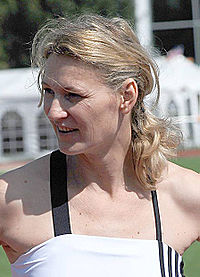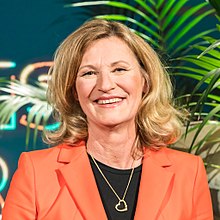Heike Henkel
| Heike Henkel medal table |
||
|---|---|---|
 Heike Henkel (2007) |
||
| Federal Republic of Germany | ||
| Olympic games | ||
| gold | 1992 Barcelona | 2.02 m |
| World championships | ||
| gold | 1991 Tokyo | 2.05 m |
| European championships | ||
| gold | 1990 split | 1.99 m |
| Indoor world championships | ||
| bronze | 1989 Budapest | 1.94 m |
| gold | 1991 Seville | 2.00 m |
| silver | 1993 Toronto | 2.02 m |
| bronze | 1995 Budapest | 1.99 m |
| European Indoor Championships | ||
| silver | 1988 Budapest | 1.97 m |
| gold | 1990 Glasgow | 2.00 m |
| gold | 1992 Genoa | 2.02 m |

Heike Henkel (née Redetzky, married Meier-Henkel since 2004 ; born May 5, 1964 in Kiel , Schleswig-Holstein ) is a former German high jumper . In the early 1990s she won six international titles. Henkel is the only high jumper to date to have been European , world and Olympic champions for three consecutive years .
Career
Heike Redetzky
She began as a gymnast at TSV Kronshagen and as a teenager was also active in fencing and basketball, and she also began athletics. In 1980 she won her first German youth championship title in the high jump with 1.84 m. From 1981 to 1983 the athletes of TSV Kronshagen started in an athletics community with Gut-Heil Neumünster . Heike Redetzky defended her youth championship title in 1981 and took fifth place at the 1981 European Junior Championships. At the German Junior Championships in 1982, she increased to the new personal best of 1.89 m and won the competition. After a weaker year in 1983, she reached fourth place at the German Indoor Championships in 1984. Her breakthrough to the national top came at the open-air championships in 1984 when she won the title ahead of Ulrike Meyfarth with 1.91 m at the same height . At the 1984 Olympic Games in Los Angeles she almost reached her best performance in qualifying with 1.90 m, in the final she finished eleventh with 1.85 m, while Ulrike Meyfarth won her second Olympic gold medal. In her last year at TSV Kronshagen, Heike Redetzky won both the German indoor and outdoor titles in 1985.
In the winter of 1985 she moved to LG Bayer Leverkusen to train with Gerd Osenberg , who had already led Heide Rosendahl and Ulrike Meyfarth to Olympic victory. At the European Championships in 1986 Heike Redetzky took sixth place with 1.90 m. The following year she reached fifth place at the European Indoor Championships and sixth at the World Indoor Championships, each with 1.91 m. At the outdoor world championships in Rome she crossed 1.96 m and, like in the hall, took sixth place. In 1988 she won her first international medal when she and Larissa Kositsina from the USSR won silver behind Bulgarian Stefka Kostadinowa at the European Indoor Championships in Budapest . In the outdoor season, Heike Redetzky improved to 1.98 m. At the Olympic Games in 1988 , she narrowly missed the finals as 13th in qualification. In winter she won an indoor medal again, at the World Indoor Championships , which like the European Indoor Championships took place in Budapest the year before, she finished third behind Stefka Kostadinowa and Tamara Bykowa with 1.94 m . On May 24, 1989, she married the swimmer Rainer Henkel in Kiel .
Heike Henkel
At the German Championships in 1989 Heike Henkel was defeated by Andrea Arens , who started for SC Charlottenburg and achieved the highest jump of her career with 1.98 m; For Heike Henkel it was the only defeat at the German championships until 1994. On August 20, 1989, she managed the first two-meter jump of her career at the sports festival in Cologne. After six years at international championships, she won her first international title at the 1990 European Indoor Championships in Glasgow with 2.00 m. Britta Vörös from the GDR came in second with 1.94 m , while Galina Astafei from Romania jumped to third place . At the European Championships in Split in 1990 , athletes from the GDR and from the Federal Republic of Germany competed in separate teams for the last time. In the high jump, the best female jumper in the GDR, Heike Balck , took fifth place. Heike Henkel won with 1.99 m ahead of Biljana Petrović from the host Yugoslav team and Jelena Jelessina from the Soviet Union, who both jumped 1.96 m.
In 1991 Heike Henkel was able to continue her successful streak. She won the World Indoor Championships in Seville with 2.00 m ahead of Tamara Bykowa and Heike Balck. At the beginning of August she crossed 2.04 m in Monte Carlo, beating Ulrike Meyfarth's eight-year-old German record. Four weeks later she climbed to 2.05 m at the World Championships in Tokyo and won with a seven-centimeter lead over Jelena Jelessina. In 1991 Heike Henkel also won the overall ranking of the Athletics Grand Prix .
At the German Indoor Championships in 1992, Heike Henkel set a new indoor world record with 2.07 m. Shortly afterwards she won the European Indoor Championships in Genoa with 2.02 m, where she had skipped all heights in the first attempt, which is why she won gold after the multiple attempt rule before Stefka Kostadinowa, who had also mastered 2.02 m. At the 1992 Olympic Games on August 7th, Heike Drechsler won gold in the long jump. The next day, Heike Henkel entered the high jump final and won with 2.02 m ahead of Galina Astafei. Both gold medals went to a German named Heike. Heike Henkel received further honors this year: after she had already received the Rudolf Harbig Memorial Prize at the German Championships , she was voted World Athlete of the Year and Germany's Sportswoman of the Year at the end of the year .
After three years in which she had won all titles, she was defeated at the World Indoor Championships in 1993 in Toronto with 2.02 m against Stefka Kostadinowa, who this time had the rule of multiple attempts on her side at the same height. In the open-air season, Henkel won the German championship title with 2.00 m, at the 1993 World Championships in Stuttgart, unlike Kostadinowa, she qualified for the final, but then did not take part due to injury.
After nine indoor championship titles in a row, Heike Henkel did not start at the German indoor championships in 1994, and her first son was born at the end of February. The young mother immediately tried to continue her career. She finished fifth at the German Open Air Championships, while Heike Balck won her first championship title after reunification. Up until the European Championships in 1994 , Henkel was in such good shape that she overcame the qualifying height of 1.92 m, but in the final she was eliminated early with 1.85 m. While Heike Balck took sixth place, another jumper from the former GDR won: Britta Vörös had married in Slovenia and won as Britta Bilac. While Britta Bilac was not a national competitor for Heike Henkel, the naturalization of Alina Astafei (previously Galina Astafei) gave her another world class athlete as an opponent. At the German Indoor Championships in 1995, Astafei won ahead of Henkel and won her first German title. In March at the 1995 World Indoor Championships in Barcelona, the three high jumpers who had received the medals at the European Indoor Championships in Glasgow five years earlier reached the podium. Astafei received her first gold medal for Germany with 2.01 m, Britta Bilac won silver ahead of Heike Henkel, both of whom had crossed 1.99 m. Astafei also defeated Henkel at the German Championships in the open-air season. At the World Championships in Gothenburg, Henkel missed the finals, while Astafei won silver behind Kostadinowa. In 1996, Henkel again finished second behind Astafei at the German Championships. After she failed to qualify for the Olympics, she ended her career.
After the birth of her second son in 1997, Heike Henkel returned to the stadiums. In 1999 she won the German Open Air Championships and the indoor title the following year. Her last big competition was at the European Indoor Championships in Ghent in 2000 , where she finished eighth with 1.85 m. In the 2000 outdoor season, she finally said goodbye as an active athlete.
After 14 years, Heike Henkel lost her indoor world record on February 4, 2006 to the Swede Kajsa Bergqvist . The jump over 2.07 m (as of November 2009) is still a German indoor record, while her outdoor record was exceeded after 18 years on June 14, 2009 by Ariane Friedrich .
Private
Heike Henkel is 1.82 m tall and weighed 62 kg at competition times. From 1989 to 2001 she was married to the swimmer Rainer Henkel ; the marriage has two children. Another daughter comes from the relationship with ex-decathlete Paul Meier , with whom she has been married since April 30, 2004. In 1996 she successfully completed her studies in graphic design with a diploma. Today she gives lectures on various topics such as motivation, success and failure. On November 6, 1997, she was awarded the Order of Merit of the State of North Rhine-Westphalia . The anti- doping fighter, who was already engaged during her career - for which she was honored with the Bambi in 1991 - was a member of the board of the national anti-doping agency NADA from 2002 to 2005 . Heike Henkel has been the patron of the outpatient children's hospice service in Cologne since January 2007.
In 2018 she took part in the RTL Ninja Warrior Germany celebrity special for the RTL donation marathon .
German championship title
- Open air: 1984, 1985, 1986, 1987, 1988, 1990, 1991, 1992, 1993, 1999
- Halle: 1985, 1986, 1987, 1988, 1989, 1990, 1991, 1992, 1993, 2000
literature
- Klaus Amrhein: Biographical manual on the history of German athletics 1898–2005 . 2 volumes. Darmstadt 2005 published on German Athletics Promotion and Project Society
- Real Federacion Espanola de Atletismo: European Indoor Handbook . Madrid 2005 ISBN 84-87704-89-1
Web links
- Personal website
- Heike Henkel in the database of World Athletics (English)
- Entry in the Leverkusen who's who
Individual evidence
- ↑ Merit holders since 1986. State Chancellery of the State of North Rhine-Westphalia, accessed on March 11, 2017 .
- ↑ a b Heike Henkel - Successes and Awards. Retrieved April 21, 2017 .
- ^ German Children's Hospice Association - Patrons
| personal data | |
|---|---|
| SURNAME | Henkel, Heike |
| ALTERNATIVE NAMES | Redetzky, Heike; Meier-Henkel, Heike |
| BRIEF DESCRIPTION | German high jumper and Olympic champion |
| DATE OF BIRTH | 5th May 1964 |
| PLACE OF BIRTH | Kiel , Schleswig-Holstein , Federal Republic of Germany |
